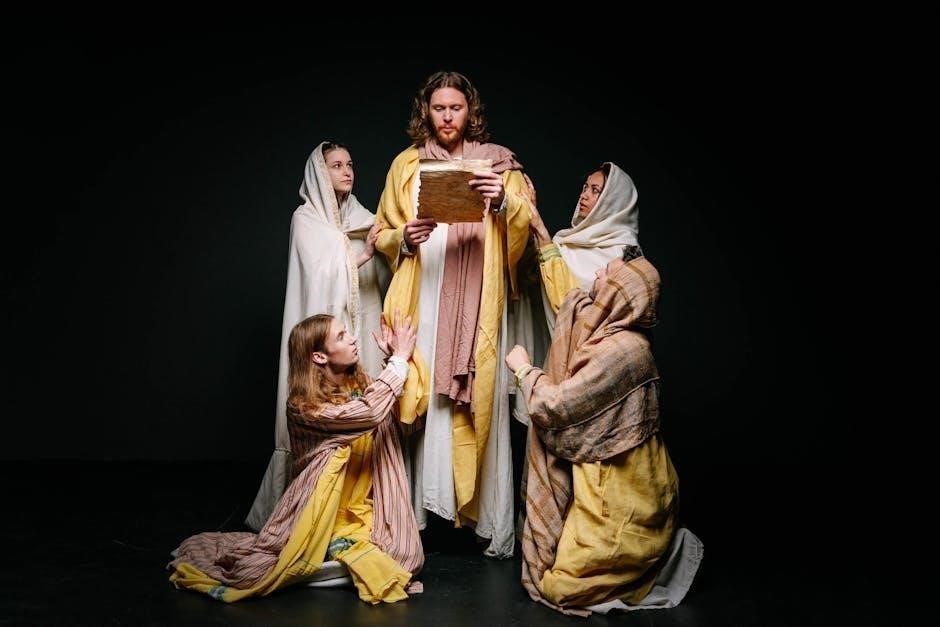
The Parable of the Sower, found in the Synoptic Gospels, tells the story of a farmer scattering seeds on four different soils, symbolizing humanity’s varied responses to God’s message.

The Biblical Story of the Parable
Jesus taught the Parable of the Sower to a crowd by the lake, describing a farmer scattering seeds on four types of soil, illustrating how people respond to God’s message.
2.1. The Four Soils
The story describes four types of soil where the seeds fell: the path, rocky ground, thorny soil, and good soil. Each represents different human responses to God’s Word. The path symbolizes those who fail to understand, the rocky ground those with fleeting faith, and the thorny soil those distracted by worldly concerns. Only the good soil produces fruit, signifying those who truly embrace and nurture God’s message in their hearts.
2.2. The Sower and the Seed
The sower in the parable symbolizes Jesus Christ, who spreads the Word of God, represented by the seed. The seed itself embodies the message of the Kingdom of God, intended to take root in human hearts. The sower’s act of scattering seeds illustrates the universal offer of salvation, available to all who are willing to receive it. The seeds are not selective; they fall wherever they may, leaving the outcome dependent on the soil’s condition. This emphasizes the sower’s generosity and the universal nature of God’s grace. The seed’s quality remains consistent, highlighting that the focus is not on the sower or the seed but on the receptiveness of those who hear the message.

Symbolism in the Parable
The parable uses the sower, seed, and soils to symbolize the spread of God’s Word and humanity’s varied responses to divine truth, highlighting growth and challenges.
3;1. The Sower
The sower represents Jesus Christ and His followers who spread the Word of God. In the parable, the sower is not selective about where the seed falls, symbolizing God’s universal grace and the indiscriminate offering of salvation to all. This imagery highlights the sower’s role as a divine messenger, scattering seeds without bias, allowing the soil’s condition to determine growth. The sower’s action reflects the divine plan to reach every heart, emphasizing the responsibility of believers to share the Gospel freely. This symbolism underscores the importance of outreach and the universal invitation to receive God’s message, regardless of individual circumstances or readiness.
3.2. The Seed
The seed in the parable symbolizes the Word of God or the Gospel message. It represents the divine truth and spiritual nourishment offered to humanity. The seed’s universality and purity emphasize that God’s message is consistent and unchanging, sown equally in every heart. Its potential for growth depends on the soil’s condition, mirroring how individuals receive and respond to God’s Word. The seed’s ability to bear fruit reflects the transformative power of the Gospel when embraced with faith and openness. This imagery underscores the importance of spiritual receptivity and the role of believers in nurturing the seed of truth within themselves and others. By focusing on the seed, the parable highlights the universal call to embrace God’s message and allow it to flourish in one’s life.
3.3. The Soils
The soils in the parable symbolize the various conditions of human hearts and their receptivity to God’s Word. The hardened path represents those who fail to understand or embrace the message, often due to indifference or spiritual blindness. The rocky ground signifies individuals who initially receive the Word with enthusiasm but lack the depth of faith to sustain it through trials. The thorny soil symbolizes those consumed by worldly cares and desires, which choke the growth of spiritual fruit. Finally, the good soil represents hearts that are fertile, humble, and receptive, allowing the Word to take root and bear abundant fruit. These soils serve as a reflection of our own spiritual state and challenge us to examine how we respond to God’s message in our lives.

Historical and Cultural Context
The Parable of the Sower, rooted in the Synoptic Gospels, reflects 1st-century Palestinian agriculture and Jewish culture, emphasizing the Kingdom of God’s message and human responses.
4.1. Origins in the Synoptic Gospels
The Parable of the Sower is recorded in three Synoptic Gospels: Matthew, Mark, and Luke. Each account shares the core story but varies in detail.
Matthew 13:1-23 provides the most comprehensive narrative, while Mark 4:1-20 offers a concise version. Luke 8:4-15 includes additional insights into Jesus’ teachings.
Scholars believe the parable originated from Jesus’ public ministry, where He used it to explain the Kingdom of God’s nature.
By including His own explanation, Jesus emphasized the importance of understanding the parable, making it a central teaching in Christian doctrine.
The slight differences across Gospels highlight the unique styles of each evangelist while preserving the parable’s universal message.
4.2. Cultural Relevance
The Parable of the Sower holds profound cultural relevance, transcending its biblical origins to resonate with contemporary societal challenges.
It addresses themes of inequality, societal decay, and the struggle for survival, which are timeless and universal concerns.
In modern contexts, the parable is often linked to issues like poverty, lawlessness, and the erosion of educational opportunities.
Authors like Octavia Butler have reinterpreted it in dystopian literature, such as her novel Parable of the Sower, to depict a chaotic future where societal structures collapse.
Such adaptations highlight the parable’s enduring message about the need for resilience and hope amidst adversity.
Its cultural significance lies in its ability to inspire reflection on humanity’s condition and the importance of nurturing spiritual and moral growth in turbulent times.

Modern Interpretations
The Parable of the Sower is widely used in educational settings to explore themes like social justice, inequality, and environmental degradation, resonating with contemporary global challenges.
5.1. Social and Economic Issues
The Parable of the Sower addresses social and economic disparities, reflecting on how societal conditions affect individuals’ ability to thrive. Jesus’ story parallels modern struggles with poverty, inequality, and access to resources. The seeds falling on different soils symbolize how systemic issues can hinder personal growth and opportunities. This parable encourages reflection on how economic systems and social structures impact people’s lives, emphasizing the need for equity and compassion. By examining the parable through this lens, it becomes a powerful tool for advocating social justice and addressing the root causes of inequality in today’s world. The parable’s timeless message continues to inspire efforts to create a more just and equitable society for all.
5.2. Educational Use
The Parable of the Sower is widely used in educational settings to teach spiritual, moral, and cultural lessons. Educators incorporate it into syllabi and study guides to help students analyze its deeper meanings and apply them to real-life scenarios. The parable’s universal themes, such as receptivity, growth, and the impact of external factors, make it a valuable tool for fostering critical thinking and reflection. Many PDF resources, such as study guides and lesson plans, are available online, providing structured approaches for teaching this parable in classrooms. These materials often include discussion questions, activities, and interpretations tailored for different age groups, making it accessible for both religious and secular educational contexts. This educational approach helps learners connect the parable’s ancient wisdom with contemporary issues and personal growth.

Resources for Further Study
Downloadable PDFs of the Parable of the Sower are available online, offering detailed study guides, sermons, and analyses to deepen understanding of its spiritual and cultural significance.
6.1. Downloadable PDFs
Downloadable PDFs on the Parable of the Sower offer comprehensive study materials, including detailed analyses, sermon outlines, and educational guides. These resources provide insights into the parable’s spiritual and cultural significance. Many PDFs include historical context, modern interpretations, and practical applications for daily life. For example, the Parable of the Sower (Earthseed, 1) by Octavia E. Butler is available as a downloadable PDF, offering a unique literary perspective on the story. Websites like Lythrum Press provide easy access to these materials, enabling readers to explore the parable’s depth and relevance. Whether for personal study or group discussions, these PDFs are invaluable tools for understanding the parable’s enduring message and its impact on faith and society.

Application in Daily Life
The Parable of the Sower offers timeless wisdom for daily living. It teaches the importance of receptivity, perseverance, and nurturing spiritual growth. Just as the sower scatters seeds, we can share love, kindness, and truth, trusting that some will take root. The parable encourages self-reflection: Are we like the fertile soil, allowing God’s Word to transform us? It also reminds us to be patient and persistent, as not all seeds bear fruit immediately. In relationships and personal growth, the parable inspires us to identify and cultivate the “good soil” within ourselves and others. By applying its lessons, we can live intentionally, prioritizing what truly matters and yielding a harvest of faith, hope, and love in our lives and communities.
